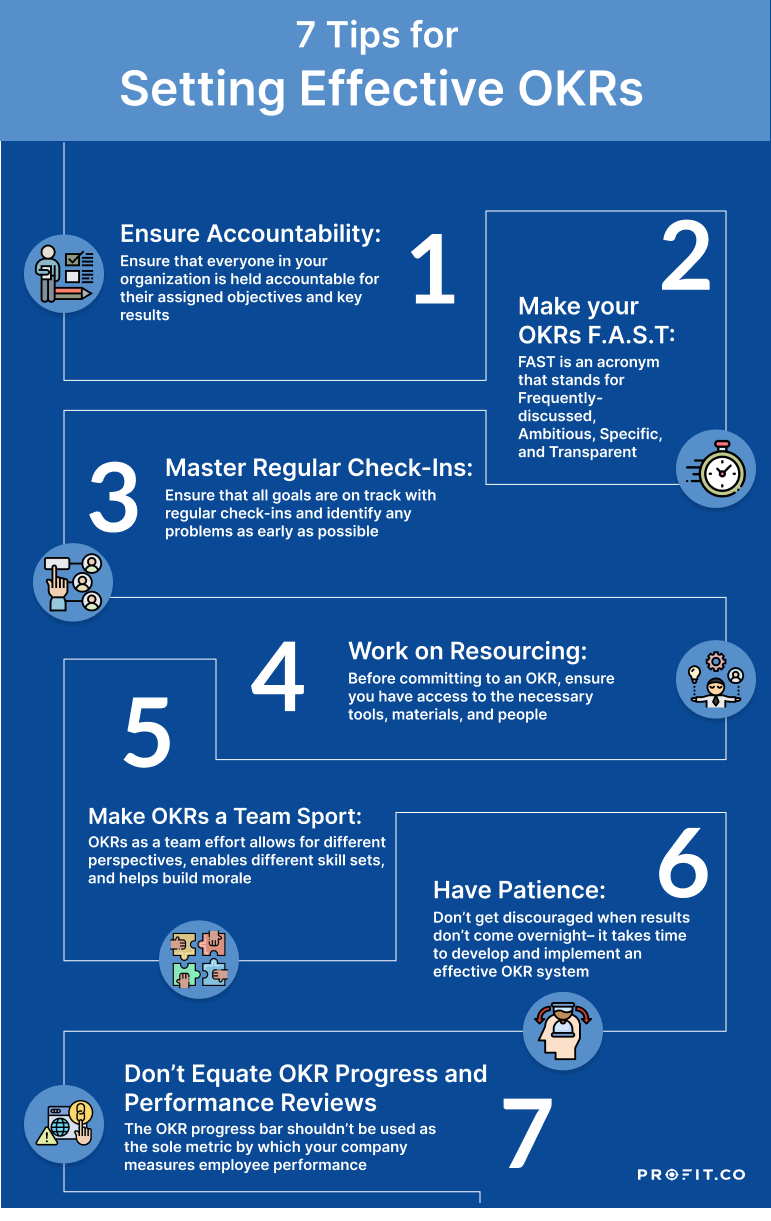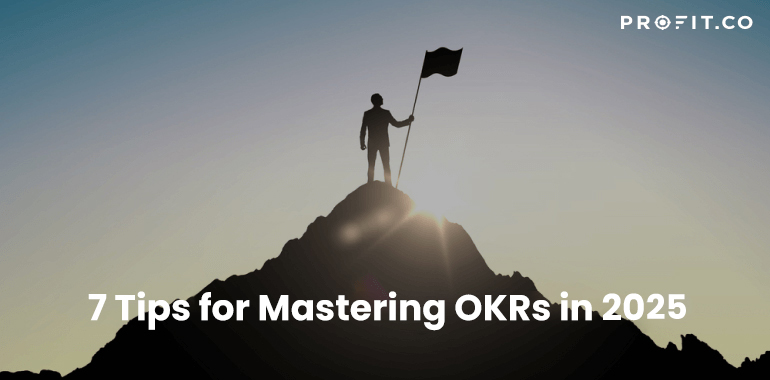In 2022, OKRs are more important than ever for businesses looking to achieve success. In today’s fast-paced and constantly-changing world, organizations need a way to measure and track their progress quickly and easily. And OKRs provide just that.
According to the Harvard Business Review, on average, a whopping 95% of a company’s employees are likely to be unaware of, or not fully understand, its strategy. Needless to say, a team that doesn’t understand their company’s strategy is a recipe for disaster. Employees need to be aware of the company’s direction to align their own goals. This is where OKRs come in. OKRs help ensure that everyone in the organization is working towards the same objectives.
Setting goals is the first step in turning the invisible into the visible.
What are OKRs?
So, what exactly is an OKR? If you’re not familiar with OKRs, they are an agile goal-setting framework that allows organizations to set measurable goals and track progress throughout the quarter with routine check-ins and reviews. OKR stands for Objectives and Key Results.
Objectives are the goals you want to achieve, while the key results are the metrics by which you measure your progress.
For example, if your objective is to increase revenue. Your key results could be to increase the number of renewals, increase the number of inbound leads, and raise the average customer satisfaction rate.
What is a Full OKR Lifecycle?
The full OKR lifecycle is a process that helps organizations set and achieve their goals. It begins with identifying an organization’s objectives, which are then used to create key results. These key results are then monitored and updated periodically, and adjustments are made to ensure that the organization is on track to achieving its goals.
The full OKR lifecycle is also an iterative process, and it is not uncommon for organizations to go through several cycles before they reach their desired outcomes. The key to success is to maintain focus and discipline throughout the process and continually adjust course as needed.
By following the full OKR lifecycle, organizations can increase their chances of achieving their goals and realizing their full potential.
Why Are OKRs Important?
Objectives and key results (OKRs) offer a simple yet powerful way to keep everyone in your organization aligned and focused on the most important things. By setting clear goals and measuring progress against them, you can ensure that everyone is working towards the same things and knows what needs to be done to achieve success.
Perhaps most importantly, OKRs can help you identify and track progress towards your company’s overall mission and vision. In today’s fast-paced business world, it’s more important than ever to have a laser-like focus on what’s truly important, and OKRs can help you to achieve that.
Profit.co’s OKR Management software enables you and your team to transparently track progress and goals from anywhere in the world. Whether you’re a remote team or all in the same office, everyone can stay aligned to the top-priority goals with Profit.co. Try it free today!

There are several things you can do to set effective OKRs. Here are seven tips for setting effective OKRs:
1. Ensure Accountability
One of the most important things you can do when setting OKRs is to ensure that everyone in your organization is held accountable for their results. This means that you need to have a system to track progress and hold people responsible for their results. One way to do this is to set up a meeting schedule for review and feedback or to meet one-on-one with managers and OKR-owners. This will ensure that everyone is on the same page and that progress is being made.
Mark Pierce, CEO at Cloud Peak Law Group, has said that “Any initiative should be started on the executive level first. Work on the team members who will be accountable and support other team members as active contributors and collaborators.”
2. Make your OKRs F.A.S.T.
FAST is an acronym that stands for Frequently-discussed, Ambitious, Specific, and Transparent. These are the four critical characteristics of effective OKRs. When setting and monitoring your own OKRs, refer to the components of FAST goals. Frequently discuss the progress and the relevance of the goal, ensuring the goal is ambitious and specific, and maintain full transparency when tracking progress on the goal throughout the entire quarter.
Jim Pendergast, Senior Vice President of altLINE Sobanco, suggests that FAST is much better than SMART.
“FAST goals are better than SMART goals because they’re more focused and easier to understand. You don’t need a lot of technical jargon to explain them. SMART goals tend to be more complex, which can lead to confusion.”
3. Master Regular Check-Ins
Regular check-ins are a vital part of setting and achieving OKRs. You can ensure that everyone involved is on track to meet the objectives by checking in regularly. It also allows you to identify any areas where potential problems may be. Furthermore, regular check-ins provide an opportunity for feedback, which can help to improve the overall efficiency of the process. Ultimately, mastering regular check-ins is essential for setting and achieving successful OKRs.
4. Work on Resourcing
When setting OKRs, it’s vital to ensure that you have the right resources to achieve the objectives. This means having a clear understanding of what you need and where you can get it. It also means making sure that you have the right people to do the work. Without the right resources, it will be challenging to achieve your OKRs.
5. Make OKRs a Team Sport
While creating and meeting OKRs is a key part of any organization’s success, it’s not something that can be done by one person alone. Instead, it takes a team effort to create realistic and achievable OKRs and then work together to meet those goals.
James Crawford, Co-Founder of DealDrop, believes that “OKRs shift strategy from the executive offsite to the wider leadership team and some mid-level management participants.”
There are a few reasons why making OKRs a team sport is so important.
First, it allows for different perspectives to be considered when setting objectives. What might seem like an impossible goal to one person may be achievable with the right team in place.
Second, it enables different skill sets to be used in achieving results. One person may be great at coming up with ideas but need help with implementation. Having a team in place allows different people to focus on various aspects of the process.
Finally, working as a team helps build morale and commitment to meeting the objectives. When everyone is working together towards a common goal, it’s more likely that the plans will be met.
6. Have Patience
When implementing OKRs, it’s essential to have patience. Rome wasn’t built in a day, and neither are successful OKRs. It takes time to develop and implement an effective OKR system. Don’t expect results overnight. Instead, focus on the long-term goal of achieving successful OKRs.
7. Don’t Equate OKR Progress and Performance Reviews
One of the biggest mistakes companies can make is tying OKRs and performance reviews together. While OKRs can be a good indicator of what a given team member’s responsibilities and goals are, the OKR progress bar shouldn’t be used as the sole metric by which your company measures employee performance. There are a few reasons why this is not a good idea.
First, it creates a strong incentive for employees to game the system and focus on goals that are easy to achieve rather than actual vital goals. When employees are afraid to fail, the overall performance of the team will decrease. Tina Hawk, SVP of Human Resources at GoodHire, suggests shifting employees’ focus away from their individual performance and goals.
Second, equating OKRs and performance reviews can make employees afraid to take risks. Since setting risky, ambitious goals might backfire and result in a poor performance review for the employee, employees might be less likely to stretch themselves. This means less innovation and ambition from your employees.
Finally, equating performance reviews and OKR progress can cause employees to lose sight of the company’s overall strategy and objectives. So, if you’re thinking about tying OKRs to performance reviews, during the initial rollout think again. While OKRs can help inform performance reviews, they shouldn’t be the sole indicator of an employee’s score. It’s a decision that might end up doing more harm than good.
Conclusion
OKRs can be a great way to improve the performance of your organization. However, they’re not something that can be implemented overnight. It takes time, effort, and patience to develop and implement an effective OKR system. However, by following the tips above, you’ll be well on your way to mastering OKRs in 2022.
To learn how Profit.co’s OKR Management platform can help take your OKR program to the next level with transparent OKR tracking and at-a-glance progress updates, schedule a free demo with Profit.co’s OKR experts!

